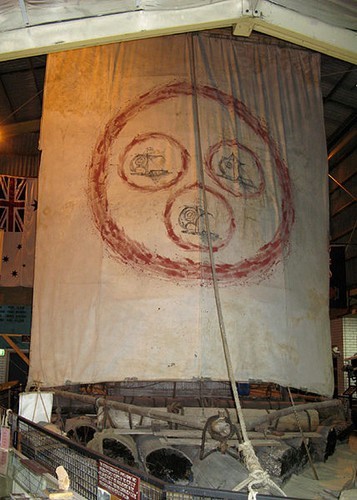Aztlan and the Amazing trans-Pacific Sail
by The Advocate/ Sail-World Cruising on 13 Dec 2008

Aztlan - image on sail designed by Salvador Dali SW
Just 35 years ago, 12 men set sail from the South American country of Ecuador in three sailing rafts made of balsa logs, and arrived successfully, 178 days later, in Ballina, on the east coast of Australia.
Recently, one of those crew members, if that's the right expresssion, Gabriel Salas, returned to visit the raft, called Aztlan, which is still in Ballina. The story of the journey is an amazing account, not only of survival, but of great seamanship.
'I feel a strong connection to this raft,' Mr Salas, now aged 65, said as he looked over the Aztlan.
Last month marked the 35th anniversary of the arrival of those rafts in Ballina - and Mr Salas had made the trip up from his home in Maitland just north of Sydney to see his raft again.
He has fond memories of the 1973 voyage - the longest raft voyage ever recorded - describing it as a 'holiday'.
He had made the same voyage three years earlier in the La Balsa expedition where just one raft sailed from Ecuador to Mooloolaba, a popular river harbour on the Queensland coast.
And he said he would love to do the trip again.
The La Balsa and the Las Balsas expeditions were led by Vital Alsar. The Las Balsas crew came from America, Canada, Mexico, Chile and Ecuador. They followed Thor Heyerdahl's famous 1947 voyage of the Kon-Tiki raft from South America to the first islands of the Tuamotu Archipelago, about half-way across the Pacific.
La Balsa aimed to prove rafts could sail further than Kon-Tiki, and the Las Balsas expedition aimed to prove that large numbers of people could have sailed into the Pacific from South America.
Recent DNA evidence points to quite an opposite story of the settlement of Polynesia. Those who liked the Thor Heyerdahl theory, pointed to the existence of the South American sweet potato in Polynesia, which could have come across on rafts. However, recent evidence of Polynesian chickens' DNA in South America, along with the DNA evidence that the Polynesians and Melanesians came from the north west, lends weight to the idea that the Polynesians traded with the South Americans, and took their chickens there, bringing the sweet potato back.
Mr Salas is quick to point out the crew were 'not anthropologists' and were not trying to weigh into the debate as to which direction the Pacific islands were settled from, the east or west. But he said there were legends of 100 rafts and more setting sail from South America on balsa-wood rafts.
'Fleets of rafts could have transported whole ethnic groups carrying with them technology, arts, crafts, music, religion, writing, etc and thus have major impacts on the places where they arrived,' he said.
The Las Balsa rafts - Guayaquil, the Mooloolaba and the Aztlán - were each made of seven balsa logs tied together with hemp rope.
The design of the 14m by 7m rafts was based on historical drawings and descriptions, and no modern materials were used in their construction. They had a canvas sail supported by a hardwood mast and 'guaras,' or moving keel boards, also made of hardwood, which were inserted between the balsa logs to steer the rafts. The living quarters were built over a bamboo base, and the rafts were equipped with radios.
Setting sail from Ecuador they commenced their drift across the Pacific Ocean via the Galapagos Islands, The Society, The Cook Islands, Tonga, South of New Caledonia and then arrived off Mooloolaba. The weather was bad and the prevailing currents carried them down the coast to Ballina, New South Wales.
Australia's ship the HMAS Labuan followed their drift and it was decided to tow them into Ballina with the aid of local fishermen. One raft was breaking up and close to floundering so it was abandoned and left to drift on and was eventually washed up on the beach in Newcastle. After 9,000 miles and 178 days at sea the crews were given a heroes welcome by the people of Ballina.
On the journey there were close encounters with whales and plenty of sharks along the way. Mr Salas said the logs became a home to crustaceans which attracted smaller fish, and the larger fish followed - there was plenty to eat during the voyage.
One of the rafts became separated from the other two during a storm which lasted about five days, during which the rafts were battered by seas of up to 10m. He said rafts were one of the safest vessels to sail in because they couldn't capsize. After several days and radio calls through the ham radio network, the third raft appeared on the horizon and the voyage continued.
During the voyage, Mr Salas' homeland of Chile came under military rule. After his arrival in Ballina, the Prime Minister of Australia of the time, Gough Whitlam, in a meeting in Canberra with the Las Balsas crew, personally offered Mr Salas and another Chilean on board refugee status, which they accepted.
Mr Salas said he had lost contact with the other 10 crew members, and said that at least two - and no doubt more - had passed away.
The amazing Aztlan is on display at the Ballina Naval and Maritime Museum in Ballina - worth a stop to marvel if you ever visit Australia.
If you want to link to this article then please use this URL: www.sailworldcruising.com/51809